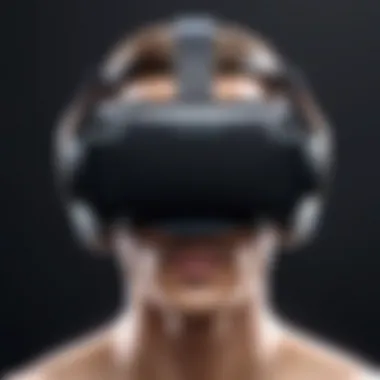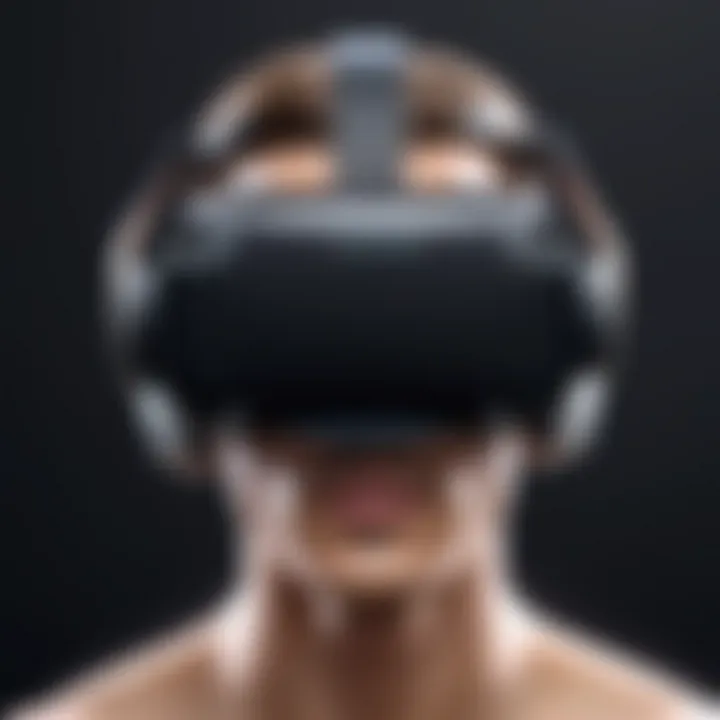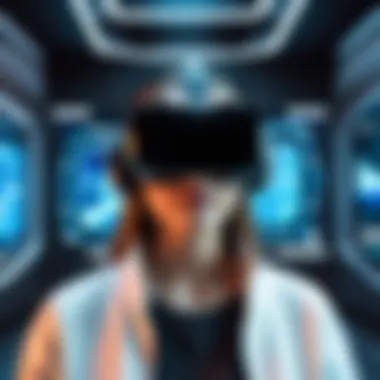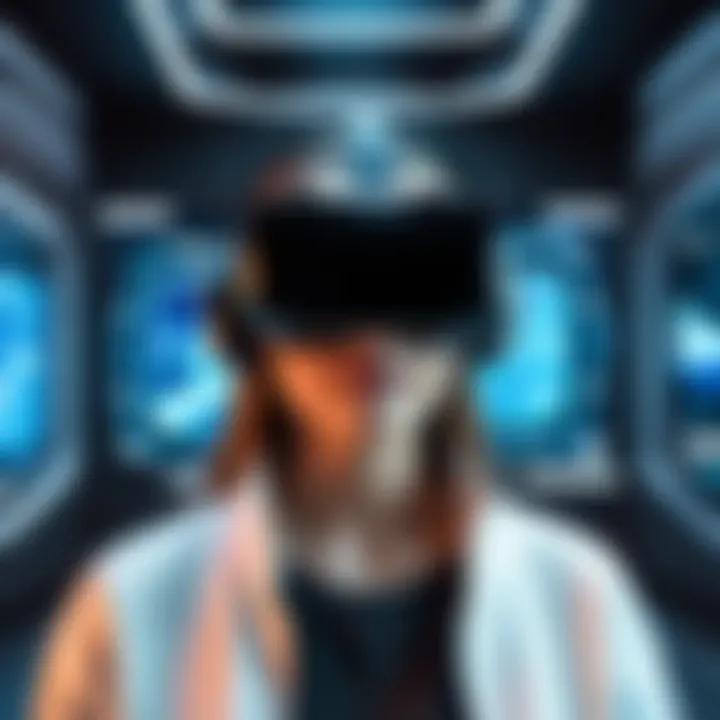Understanding Virtual Reality Sets: A Comprehensive Guide


Intro
Virtual reality (VR) has transformed the landscape of technology, interacting with numerous fields beyond just gaming. This guide aims to clarify the multifaceted nature of VR sets, shedding light on their components, functionality, and varying applications. By dissecting the types of VR sets available on the market and their technological underpinnings, we seek to illuminate the user experience trends and essential considerations for prospective buyers. Moreover, the exploration of future trends in VR technology should facilitate an understanding of the evolving digital frontier and how it influences daily life.
Software Overview
Features and functionalities
A pivotal aspect of any VR set lies in its software, which orchestrates the user interactions and experiences. Typically, VR software encompasses games, applications, and environments specifically designed to immerse users. These applications leverage unique characteristics like spatial awareness and interactive controls. Noteworthy options include Oculus Home for Oculus Rift sets, SteamVR for HTC Vive, and PlayStation VR for Sony's console, all offering distinct features tailored to various preferences and scenarios.
Pricing and licensing options
The pricing strategy for VR software varies widely. Oculus Home offers a mix of free and paid content, with games sometimes reaching upwards of fifty dollars. SteamVR provides a comprehensive library where pricing can often fluctuate due to seasonal sales. Licensing can also come into play, especially for businesses looking to use VR for training or simulations. Subscriptions fees might apply to enterprise-oriented platforms such as VirtaMed or SimSchool.
Supported platforms and compatibility
Compatibility is an essential consideration. Oculus Rift primarily supports Windows platforms, while HTC Vive operates similarly but also offers some mobile solutions. PlayStation VR hinges on PlayStation 4 or 5, indicating that users must align their VR sets with corresponding hardware to ensure optimal performance.
User Experience
Ease of use and interface design
User experience plays a significant role in VR adoption. Generally, a good VR interface serves as an intuitive entry point. This simplicity is crucial, especially for new users. The arrangement of menus, the responsiveness of controls, and overall navigation determine the user's comfort and willingness to engage in immersive experiences.
Customizability and user settings
Customization options cater to individual preferences and physical capabilities. Users may tweak graphical settings, adjust comfort levels, and personalize control schemes to enhance engagement and minimize discomfort. Such flexibility is vital for users with varied backgrounds and familiarity with technology.
Performance and speed
Performance metrics significantly alter user experience. A smooth frame rate is critical in preserving immersion and reducing motion sickness. VR sets should ideally maintain at least 90 frames per second to achieve a fluid experience, as lower rates tend to disrupt immersion and lead to user discomfort.
Pros and Cons
Strengths and advantages of the software
- Enhanced immersion and engagement through realistic simulations.
- Broad applications spanning entertainment, education, and industry training.
- Continuous updates and improvements in software capabilities.
Drawbacks and limitations
- Expensive initial investment, particularly for high-end models.
- Requires dedicated physical space for optimal usage.
- Potential for motion sickness among susceptible users.
Comparison with similar products
When weighing VR sets against other mediums, VR offers unparalleled immersion. Traditional gaming or cinema lacks the spatial interactivity present in VR systems. However, each platform has its merits. For instance, while PC gaming provides superior graphical performance, VR technology focuses on experiential depth.
Real-world Applications
Industry-specific uses
VR finds utility in numerous industries, including healthcare, education, and entertainment. In medical training, for example, simulations can allow for risk-free practice, creating significant learning opportunities. Furthermore, companies like Boeing utilize VR to enhance their design processes.
Case studies and success stories
Oculus has partnered with institutions to create educational experiences that enhance learning through simulation. In tourism, companies now offer virtual experiences that allow users to explore destinations before making travel decisions. This approach leverages VR to foster informed consumer choices.
How the software solves specific problems
VR technology addresses challenges such as skill acquisition in complex tasks. By offering controlled environments and repeatable simulations, it enables practical learning without real-world consequences.
Updates and Support
Frequency of software updates
Most VR software developers release regular updates. Such updates tend to fix bugs, introduce new features, or enhance performance. Staying current can be crucial to maintaining a seamless user experience.
Customer support options
Support varies by brand. Companies like Oculus provide comprehensive customer support through online assistance, FAQs, and direct service options. User experience with support can significantly impact overall satisfaction.
Community forums and user resources
Online communities have blossomed, especially on platforms such as Reddit. These forums act as valuable resources for users seeking advice, troubleshooting tips, or general discussions about VR technology.
"The future of virtual reality is not limited to entertainment; it stretches into education, mental health therapy, and professional training."
Intro to Virtual Reality Sets
Virtual reality sets have emerged as pivotal tools in various sectors, capturing attention from both consumers and businesses alike. Understanding these devices is vital for anyone looking to leverage the power of immersive technology. The significance of virtual reality stems from its ability to provide experiences that go beyond traditional interaction models. It shapes how users engage with content, whether for entertainment, education, training, or even therapeutic purposes.
The benefits of virtual reality sets are numerous. They offer users unique experiences that can enhance learning and retention. For businesses, integrating VR into their operations can result in significant efficiencies and innovations. As the demand for immersive experiences continues to grow, comprehensively understanding VR sets makes it easier to identify the right technology for specific needs.
There are several elements to consider when exploring virtual reality systems. These include the technology behind the devices, the platforms available, and how to implement VR solutions effectively. Moreover, understanding the potential drawbacks, such as the requirement for specialized hardware and the challenges that can arise regarding accessibility, remains crucial.
The advancement of virtual reality sets is not just about improving user engagement; it's about redefining how we interact with the digital world.


Definition of a VR Set
Virtual reality (VR) sets represent a significant evolution in how users interact with digital environments. A VR set consists of hardware and software designed to create immersive experiences that engage the senses. This section will delve into the fundamental aspects of what defines a VR set, emphasizing its importance in the landscape of modern technology.
Importance of Defining VR Sets
Understanding the definition of a VR set is essential for various stakeholders, from developers to consumers. A clear definition allows for better communication about capabilities, functionalities, and potential applications. VR technology has become much more than just a tool for gaming; it is now integrated into multiple sectors including education, healthcare, and real estate. Each of these applications carries unique requirements and expectations for how a VR set should perform.
Moreover, the definition serves as a foundation for evaluating different VR systems available in the market. With numerous brands and models competing for attention, knowing what differentiates a VR set becomes crucial in making informed purchasing decisions. Factors such as resolution quality, field of view, and latency play significant roles in the overall efficacy of a VR experience.
Specific Elements of a VR Set
A VR set consists of several key components that collectively contribute to the immersive experience. Some significant elements include:
- Head-Mounted Display (HMD): The screens and optics worn on the user's head to create the visual experience.
- Sensors and Trackers: Devices that monitor user movements and provide feedback to the HMD, ensuring real-time reaction to user actions.
- Input Devices: Control mechanisms like controllers or gloves that allow users to interact with the virtual environment.
These components must function in unison to create a seamless and engaging experience. The importance of each element cannot be understated, as deficiencies in one aspect can diminish the overall user experience.
Benefits and Considerations
The primary benefit of VR sets lies in their ability to create environments that feel real to the user. This sense of presence can profoundly affect the way users learn, play, and interact with information. However, potential users should also consider several aspects before diving into VR:
- Cost: The range of prices can be vast, making it essential to evaluate what one needs versus what is offered.
- Comfort: Many users experience discomfort with prolonged use. Thus, testing comfort levels across different models is wise.
- Content Availability: Not all VR sets come with the same library of applications or games. Assessing content must align with user interests.
It's essential to recognize that VR technology is continuously evolving. As new models and innovations emerge, so too does the definition of what makes a VR set effective and user-friendly.
In summary, defining a VR set is not merely an academic exercise; it has real implications for technology designers, businesses, and end-users. The components, benefits, and considerations that make up a VR set contribute to a deeper understanding of this powerful technology. This understanding paves the way for maximizing the potential of virtual reality across various facets of society.
Components of a VR Set
Understanding the components of a Virtual Reality (VR) set is vital for grasping how these systems function and how they enhance user experience. Each element plays a critical role in delivering immersive and interactive environments. By examining these components, users can better appreciate what features are essential in a VR system, helping them make informed decisions when selecting a VR set.
Head-Mounted Display (HMD)
The head-mounted display is one of the most crucial components of a VR set. It is the device that an individual wears over their eyes to experience virtual environments. Typically, HMDs utilize two screens, one for each eye, to create a stereoscopic 3D effect. This helps to simulate depth and gives users a sense of immersion in virtual worlds.
Key characteristics include display resolution, field of view, and refresh rate. A higher resolution offers clearer visuals, while a broader field of view enhances the sense of presence. Refresh rate can impact motion sickness, which is a common side effect of VR.
Selecting a high-quality HMD can significantly improve the overall VR experience, making it more engaging and less prone to discomfort.
Sensors and Trackers
Sensors and trackers are essential for monitoring user position and movement within the virtual space. They detect physical movements, translating them into digital input that allows the user to interact with the environment. This interaction is crucial for applications such as gaming or training simulations.
Types of sensors include gyroscopes, accelerometers, and outside-in systems, which utilize external cameras to track the position of devices in 3D space.
These components enhance the realism of the experience, providing a seamless connection between the user and the digital experience. It is necessary to evaluate the tracking accuracy and responsiveness when procuring a VR set, as this affects user engagement.
Input Devices
Input devices help users manipulate and engage with the virtual environment. Various input mechanisms exist, providing diverse ways to interact with VR.
Controllers
Controllers are handheld devices that allow users to interact with the virtual world. They often include buttons, thumbsticks, and motion sensors that translate physical movements into digital commands.
Key characteristic of controllers is their versatility for different gaming genres and applications. They are a popular choice for many users due to their familiar design akin to traditional gaming controllers.
One notable feature of some controllers is haptic feedback, which provides tactile responses during use. This feature increases immersion by simulating sensations like vibrations. However, some users may find the size and weight of certain controllers uncomfortable during extended sessions.
Gloves
Gloves are another input method providing a more nuanced approach to interaction. They can track hand movements and individual finger gestures, allowing for intricate manipulations of virtual objects.
Key characteristic of gloves is their ability to promote natural interaction, particularly in applications that require fine motor skills. They can significantly enhance tasks in education and training settings.
However, the cost and bulkiness of some glove systems can be a drawback, limiting accessibility for some users looking for a VR solution.
Other Input Methods
Other input methods, such as eye-tracking devices and voice activation systems, are emerging to offer a more seamless VR experience. These methods expand the ways users can engage without physical limitations.
Key characteristic of these options is their potential for making VR more accessible to individuals who may struggle with conventional input devices.
While eye-tracking can provide deeper insights into user engagement, implementation can be inconsistent, which may frustrate some users.
Types of VR Sets
Understanding the various types of virtual reality (VR) sets is crucial for anyone navigating the VR landscape, from enthusiasts to industry professionals. Each category offers different capabilities, user experiences, and potential applications. These distinctions can influence not only user preferences but also the suitable environments for using these technologies. Knowing the types helps in making informed decisions, whether for personal use, educational tools, or business applications.
Tethered VR Sets
Tethered VR sets offer a high-quality experience, typically connecting to a powerful computer or console. The technology here relies on robust hardware, allowing for intricate graphics and detailed environments. Devices like the Oculus Rift and HTC Vive exemplify this category.
The advantages of tethered VR include:
- High Performance: Enhanced graphics and processing capabilities provide a more immersive experience.
- Comprehensive Experiences: Users can access larger, more detailed virtual environments.
- Professional Applications: Ideal for design simulations, professional training, and gaming.


However, tethered systems have some limitations. Users are restricted by cables, which can hinder movement and disrupt immersion. Setting up these systems can also require significant space and technical knowledge.
Standalone VR Sets
Standalone VR sets represent a more convenient option, integrating all necessary computing components into the headset itself. Devices like the Oculus Quest series fall into this category. These headsets do not require a connection to a PC or external sensors, which enhances mobility and usability.
Key benefits of standalone systems include:
- Portability: Users can easily take these devices to various locations.
- User-Friendly: Less setup is needed compared to tethered systems, making them more accessible to newcomers.
- Cost-Effective: Often more affordable due to lacking the need for external hardware, they appeal to a broader audience.
Yet, they may struggle with performance compared to tethered setups, offering less detailed graphics or depth in some applications. Nonetheless, standalone devices present a solid option for casual gaming and general VR experiences.
Mobile VR Sets
Mobile VR sets utilize smartphone technology to create virtual reality experiences. Devices like the Samsung Gear VR and Google Cardboard exemplify this category. Mobile VR is accessible, as it allows users to use the device they likely already own.
This type has some compelling features:
- Accessibility: Preparedness benefits from using existing smartphones for VR experiences.
- Affordability: Often the lowest entry point into VR, making it easy for users to start exploring.
Conversely, mobile VR can be limited. Graphics and processing are tied to the smartphone's capabilities, which may not match the experience tethered or standalone sets can provide. Additionally, some users find that prolonged use can lead to discomfort due to less immersive technologies.
In summary, understanding these types of VR sets can guide informed purchasing decisions and applications. Each has its strengths and weaknesses, which can benefit various user needs, making them valuable tools in the evolving landscape of virtual reality.
How VR Sets Work
Understanding how VR sets work is crucial for grasping their utility and potential across various industries. The effectiveness of a VR set relies heavily on both the rendering processes and interaction mechanics. Together, these elements create an immersive experience that brings virtual environments to life. This section will detail these intricacies, exploring not just the technology itself, but also its impact on user engagement and experience.
Rendering Processes
Rendering in virtual reality is a complex procedure that translates 3D models into a viewable format for the user. Unlike traditional displays, rendering for VR requires a continuous, low-latency frame rate to maintain immersion and prevent motion sickness. Important aspects of rendering processes include:
- Frame Rate: A high frame rate, typically 90 FPS or higher, is essential. This helps prevent lag between a user's head movements and the image displayed.
- Field of View: This refers to the visual area that the VR display covers. A wider field enhances immersion by allowing users to perceive their surroundings more naturally.
- Stereoscopic Rendering: VR devices typically use two images to create depth perception, simulating how humans view the world with both eyes. This is pivotal for creating a convincing and realistic environment.
- Graphics Engine: Powerful engines like Unity and Unreal Game Engine optimize 3D rendering. They allow developers to create complex worlds that can be interactively explored.
Rendering processes enable users to experience environments in a way that is dynamic and responsive to their movements. The quality of rendering significantly influences how engaging the virtual reality experience is.
Interaction Mechanics
Interaction mechanics are at the heart of VR sets. They determine how users engage with content and environments, making the virtual experience tangible. Key considerations include:
- Real-time Interaction: The responsiveness of the VR environment to user input is vital. Latency should be minimal to ensure movements match expectations.
- Input Devices: Controllers, gloves, and even full-body tracking systems are used in VR. Controllers often incorporate haptic feedback, providing users with tactile responses that enhance realism.
- Gesture Recognition: Advanced VR setups can track body movements and gestures. This allows for more natural interaction without the need for physical controllers, promoting a deeper level of engagement.
- User Interfaces: Simple and intuitive interfaces are critical for maintaining user immersion. Ideally, these interfaces should feel seamless within the VR space.
Overall, interaction mechanics play a significant role in shaping user experiences. They bridge the gap between reality and the virtual world, making interactions feel genuine and impactful.
Effective rendering and interaction mechanics are what elevate virtual reality from a mere visual experience to an immersive engagement tool.
Applications of VR Sets
Virtual reality technology has evolved significantly and its applications are diverse and impactful across various sectors. Understanding these applications is crucial because it highlights the potential and versatility of VR technology. From entertainment to training in complex environments, the relevance of VR sets in modern society is extensive. Various benefits stem from each application, and they can transform experiences, enhance learning, and even improve health outcomes.
Gaming and Entertainment
The gaming industry was among the first to embrace virtual reality. VR sets have transformed gaming from traditional experiences into immersive worlds. Players can engage with environments that feel real, enhancing their enjoyment and involvement.
Key benefits of VR in gaming include:
- Immersion: Players experience a 360-degree environment which heightens realism.
- Interactivity: Users can interact with game elements in a more natural way, enhancing overall gameplay.
- Novelty: New genres and types of gameplay arise, providing unique experiences.
Popular titles like Half-Life: Alyx and Beat Saber showcase the potential for engagement in VR gaming. This sector continues to innovate and attract attention, making it a central application of VR technology.
Education and Training
Virtual reality plays a vital role in education and vocational training. By simulating real-world scenarios, VR offers cost-effective and safe learning environments. This is especially valuable in fields like aviation, medicine, and engineering.
Benefits include:
- Safe Simulations: Students can practice skills without risks associated with real-life scenarios.
- Enhanced Retention: Learning through interaction enhances memory retention.
- Accessible Learning: VR can provide experiences to students who may not have access otherwise, such as lab sessions or field trips.
Institutions are increasingly integrating VR into their curricula, offering programs that mimic real workplace conditions and challenges.
Healthcare Applications
The healthcare sector is seeing substantial advancements due to VR technology. From training simulations to patient treatment, the applications are diverse.
Key uses include:
- Surgical Training: Surgeons can practice procedures in a virtual environment, gaining hands-on experience before performing real surgeries.
- Pain Management: VR has been used to distract patients during painful procedures, effectively reducing stress and anxiety.
- Rehabilitation: Customized VR programs help patients recover from injuries in engaging ways.
These applications demonstrate how VR can enhance medical training and patient care, leading to improved outcomes.
Virtual Tours and Real Estate
In real estate, VR technology provides virtual tours that allow potential buyers to experience properties from anywhere in the world. This application has gained traction, especially during times when in-person visits are limited.
Important elements include:


- Convenience: Virtual tours save time for both buyers and agents, allowing clients to explore multiple properties without needing to be physically present.
- Realistic Experience: With 3D environments, clients gain a clearer understanding of what a property looks like.
- Targeted Marketing: Agents can reach wider audiences with virtual open houses.
As the real estate market evolves, VR technology is becoming an essential tool for property sales and marketing.
Overall, the applications of VR sets are extensive and continually expanding. The profound effects on gaming, education, healthcare, and real estate highlight a technological shift with significant implications for society.
Evaluating VR Sets
Evaluating VR sets is crucial when considering the investment in this technology. The market is saturated with various options, each tailored for different needs and preferences. A thorough evaluation not only guides consumers toward informed decisions but also maximizes the potential benefits of using VR technology in personal or professional settings.
Key Features to Consider
When evaluating VR sets, there are several key features that stand out as vital. These include:
- Resolution and Refresh Rate: Higher resolution leads to clearer images, enhancing immersion. A higher refresh rate contributes to smoother movement, reducing motion sickness.
- Field of View (FOV): This defines how much of the virtual environment the user can see. A wider FOV provides a more immersive experience.
- Tracking Technology: Accurate tracking ensures that movements are reflected in the virtual space in real time, essential for a seamless experience.
- Compatibility with Software: Buyers should ensure the VR set they choose is compatible with the desired applications, especially for gaming or training programs.
User Experience and Comfort
User experience is a primary consideration when evaluating VR sets. Comfort aspects can significantly affect the overall enjoyment and usability of a VR system. Factors to assess include:
- Weight and Fit: A lightweight HMD is preferable as it reduces strain during extended use. Adjustable straps can enhance fit and comfort.
- Lens Quality: Quality lenses can help minimize eye strain over long sessions, improving comfort.
- Breaks and Space: It's advised to take frequent breaks during use. Users should also ensure they have enough space to move without encountering obstacles.
Price and Value Assessment
The price of VR sets varies greatly, from entry-level models to high-end systems. An effective value assessment involves comparing features with the price. Consider:
- Cost vs. Features: Higher pricing doesn’t automatically equate to better experiences. It's essential to weigh features against cost to find the best fit for individual needs.
- Durability and Warranty: Checking for warranty options can provide peace of mind. Durable equipment may have a higher initial cost but can save money in the long term through reduced replacement needs.
- Resale Value: Some VR systems retain value better than others. This is an important consideration for tech enthusiasts who upgrade frequently.
"Evaluating a VR set with precision leads to enhanced user satisfaction and efficacy in achieving desired outcomes, whether in business or personal use."
In summary, thorough evaluation of VR sets is essential for both casual users and professionals. Understanding specific features, comfort factors, and pricing will provide a clearer picture of what to choose in this evolving field of technology.
Future of VR Technology
As virtual reality technology progresses, its potential applications continue to expand. Understanding the future of VR is crucial for any stakeholder in this field. Companies must comprehend emerging capabilities and trends to stay competitive. Similarly, users should know what innovations may enhance their experiences, making their knowledge more significant in both leisure and professional contexts.
Emerging Trends
The virtual reality landscape is undergoing rapid transformation, with several prominent trends shaping its future. Notably, improvements in graphics quality and realism are evident. More advanced hardware and software developments allow for higher resolutions and smoother frame rates.
Another key trend is the increasing integration of social features. VR is evolving into a shared experience, allowing users to interact in virtual environments. This potential to socialize enhances the appeal of VR, attracting a broader audience.
Beyond entertainment, industries are also embracing VR for practical applications. For instance, businesses are exploring VR for remote collaboration. Teams can gather in virtual spaces, leading to innovative solutions for projects. Training programs in various fields, such as healthcare and aviation, are increasingly utilizing VR simulations for enhanced learning experiences.
"The versatility of virtual reality ensures its relevance across diverse sectors for years ahead."
Impact of AI Integration
The fusion of artificial intelligence (AI) with virtual reality presents significant opportunities. AI enhances the VR experience through improved interactivity. By utilizing machine learning, VR systems analyze user behavior to create more intuitive experiences. Personalized content delivery becomes possible, making engagement deeper for users.
Moreover, AI contributes to the realism of virtual environments. Simulating complex scenarios, such as weather changes or crowd behavior, becomes feasible with AI. This added layer of depth increases immersion, allowing users to feel more present within the VR ecosystem.
Additionally, AI can streamline development processes. Game developers and businesses can benefit from AI-driven tools. These tools assist in creating content more efficiently, resolving complex issues swiftly, and enhancing overall productivity.
In summary, the future of VR technology is bright. Emerging trends will continue to redefine how users interact with virtual environments. The integration of AI is expected to further enhance usability and realism. Stakeholders in the IT and software industries should remain attentive to these trends to harness their potential effectively.
Epilogue
The conclusion of this article is pivotal in summarizing the insights gained from our exploration of virtual reality sets. Understanding the importance of VR technology in today’s landscape is a fundamental element that can not be overlooked. As we have highlighted throughout the guide, VR sets are not merely devices for entertainment; they encapsulate a range of applications that stretch across various sectors, enhancing engagement, providing efficiency, and even offering solutions to complex problems.
From gaming to healthcare, virtual reality sets have shown their versatility and significant potential. Consider the healthcare field, where they are used for therapy and training, exemplifying how immersive experiences can lead to improved patient outcomes and better-trained professionals. Similarly, in education, VR sets facilitate experiential learning, allowing students to interact with and visualize concepts more effectively than traditional methods.
Potential buyers must consider key factors when evaluating VR sets. As we discussed, aspects such as comfort, user experience, and value for money play critical roles in making informed decisions. Virtual reality is becoming more mainstream, and with advancements in technology, the possibilities and applications will likely expand even further.
Emerging trends, such as the integration of artificial intelligence, promise to reshape how we interact with virtual environments, leading us to speculate how these technologies will evolve and blend into our daily lives. Such developments highlight the necessity for continuous learning and adaptation in the face of rapid technological advancements.
To encapsulate, the article aims to provide a comprehensive overview of virtual reality sets, aiding various audiences, including IT and software professionals, as well as businesses. We encourage such actors to delve into VR technology not only as a tool for entertainment but as a significant driver of innovation in multiple sectors.
The growth of virtual reality technology signifies a transformative shift in how we engage with digital content and each other.
This conclusion serves as a reminder of the profound impact that virtual reality technologies are set to have on various sectors in the foreseeable future.
References and Further Reading
In the rapidly evolving domain of virtual reality, drawing from reputable sources enhances understanding and enriches the learning experience. The section on references and further reading is crucial for several reasons.
1. Depth of Information
Detailed references provide insights that exceed typical overviews. They give readers access to comprehensive studies, research papers, and case analyses that can deepen their comprehension of VR technology. For instance, articles found on Wikipedia or Britannica can offer historical context and technical details that may not be fully covered in this guide.
2. Validating Claims
Citations from peer-reviewed journals or authoritative sites ensure that the information presented in the article is credible. This is vital, particularly in a technical field like virtual reality, where rapid advancements can lead to misconceptions. A reader can critically assess the quality of the information and decide its applicability to their specific context.
3. Exploring Diverse Applications
References often elaborate on niche applications of VR technology that this article might not extensively cover. For instance, research papers on VR in healthcare or education can outline effective implementations and outcomes, offering practical insights.
4. Staying Updated
As technology continues to evolve, the importance of keeping informed cannot be overstated. Suggested readings can direct interested individuals toward the latest developments in various VR applications. Communities such as Reddit can serve as forums for discussion and sharing the latest news and experiences among VR users.
Suggested Reads
- Scientific Journals and Papers
- Technical Documentation and Guides
- Books on Virtual Reality
- Search for peer-reviewed journals on platforms like Google Scholar to access the latest research in VR tech.
- Manufacturer websites often provide detailed documentation that can increase understanding of specific specifications and capabilities of VR sets.
- Look for titles focusing on both the theoretical and practical aspects of VR, as they can present a rounded view of current challenges and future directions.



